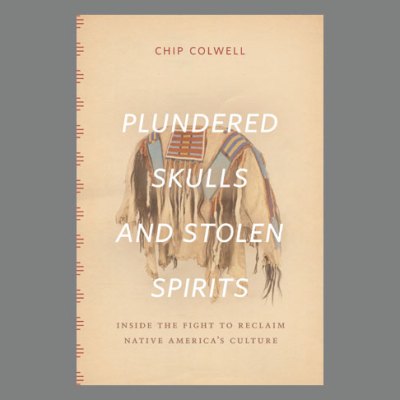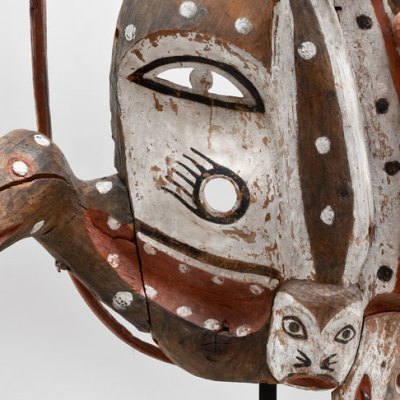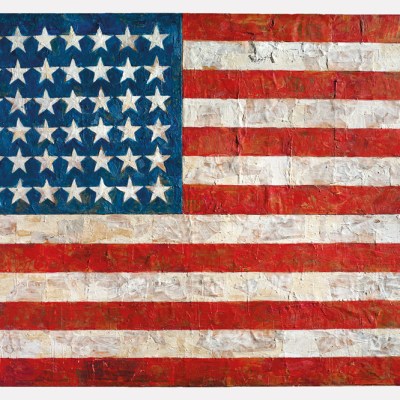From the May 2023 issue of Apollo. Preview and subscribe here.
‘I see myself as a provocateur,’ says Jaune Quick-to-See Smith. At 83, the artist is blissfully unafraid of saying what she thinks – although that doesn’t mean she’s entirely immune from jitters about the effect her provocations might have. When we speak over Zoom in early April – Smith from her studio in Corrales, just outside Albuquerque, New Mexico – the artist has just started to fret about a catalogue essay she has written, for an exhibition of Native American artists she is curating at the National Gallery of Art in Washington, D.C., later this year. She has been researching the history of Native American languages – how they describe ‘a world composed of food harvesting, of plants and animals’, but also how they were systematically suppressed in accordance with the US government’s policy of ‘assimilation’ from the 1870s. ‘The government gave us frontal lobotomies,’ Smith says. ‘And I put this in the essay.’ It’s been a while since she submitted the piece, but Smith tells me that the publishers have yet to make ‘a single comment […] which tells me that I’m being offensive again. But you know, I do it in such a nice way.’
Jaune Quick-to-See Smith photographed by Ungelbah Dávila
in 2021

Getting amiably up people’s noses is an idea that encapsulates Smith’s approach to some of her very finest paintings and sculptures. Take Target (1992), which made headlines in 2020 when it became the first painting by a Native American artist to be acquired by the NGA. Across two 1.5m-high canvases, arranged vertically, pop depictions of Native American culture (a flag for the Washington Redskins; comic books with titles such as Son of Tomahawk) are collaged on together with strips of newspaper and a series of posters advertising community events for Indigenous people. The whole is painted over with loose washes of lurid yellow and blood red; at the top of the painting is affixed a real dartboard, with darts stuck into the sides to resemble a feather headdress. Target was part of a series prompted by the government programme marking 500 years since the first transatlantic voyage of Christopher Columbus – ‘who, you know, was a terrorist’, Smith says. The series is titled I See Red, a pun that identifies it as both an expression of anger at the ways in which Native Americans had been rendered invisible during the official celebrations of the quincentennial, and an effort to correct this record. It is also a truly seductive work of art, as beguiling for its texture as it is for its witty and knowing appropriation of post-war art history – namely, Jasper Johns’ Target paintings. ‘You can catch more flies with honey than with vinegar,’ Smith explains.
Target (1992), Jaune Quick-to-See Smith. National Gallery of Art, Washington, D.C. © Jaune Quick-to-See Smith
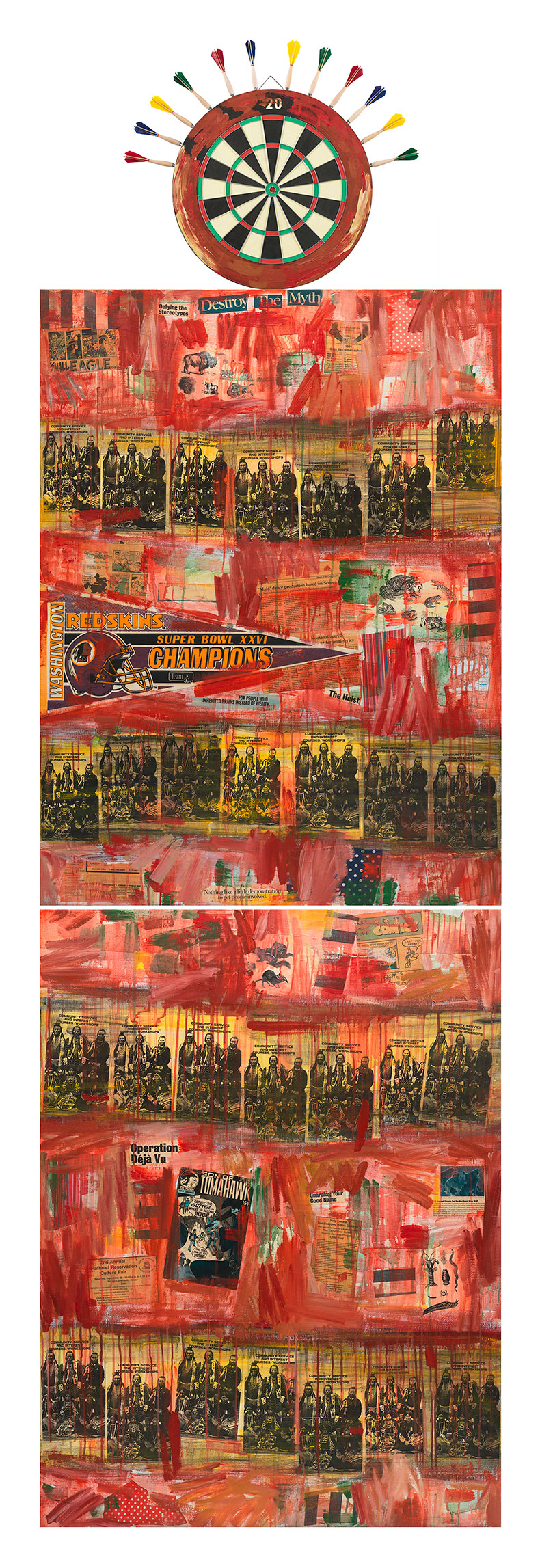
Smith spoke of ‘mixed emotions’ when the NGA bought this painting – it was a milestone in her career-long effort to dismantle what she has called the ‘buckskin ceiling’, but one that had taken much too long to come, and which she said at the time was a way for the national collection to ‘assuage the government’s guilt about an undocumented genocide’. She is similarly unromantic about the prospect of her first museum survey in New York, ‘Jaune Quick-to-See Smith: Memory Map’, at the Whitney Museum of American Art in New York (until 13 August). Rather than to, say, her own merit, Smith attributes this success to political machinations and events that go beyond her – ‘Black Lives Matter, George Floyd, Standing Rock [the site in North Dakota that in 2016 became the focus of protests against an oil pipeline]’, as well perhaps as the ‘brouhaha’ over Jimmie Durham in 2017, when a retrospective that toured to the Whitney reignited controversies over the sculptor’s claims to Cherokee heritage, which are disputed by members of the Cherokee Nation. ‘I think [the museum] sort of wanted to kick that under the rug,’ Smith says. Nonetheless, the experience of putting together over the past four years this survey of 130 works has been an illuminating one. Smith likens the process of seeking out works from private collections across the United States to an ‘archaeological dig’, working back through the strata of her past – an apt metaphor for the career of an artist whose work, in her own words, has always been ‘about the land’.
Petroglyph Park (1987), Jaune Quick-to-See Smith
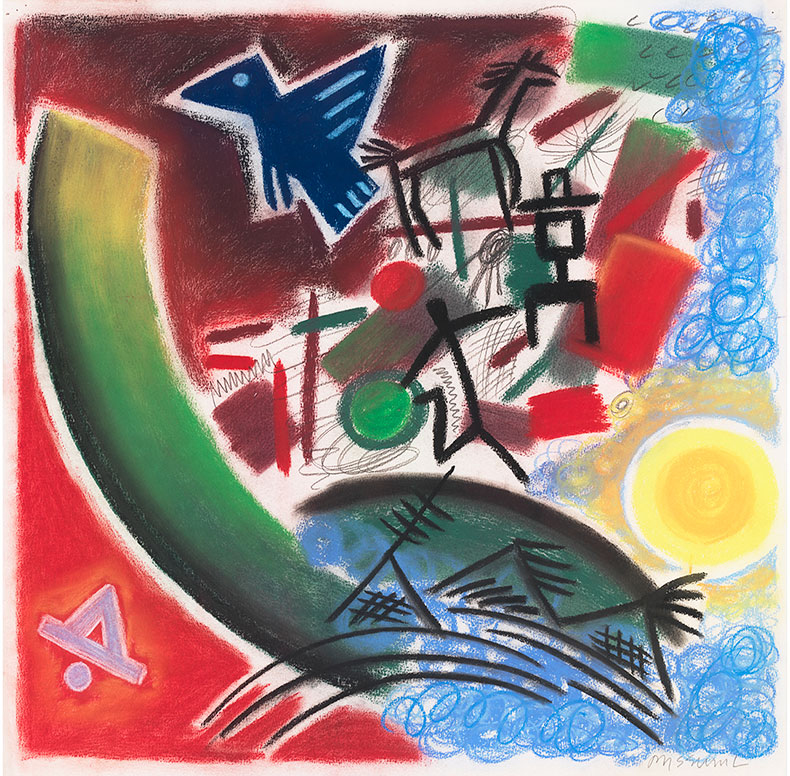
As a young girl on the Flathead Reservation, home to the Confederated Salish and Kootenai tribes of rural Montana, Smith had ‘never heard of an “artist”’ – though that didn’t stop ‘explosions going off in my head and my body’ when she first encountered tempera paints in grade school. ‘They smelled so good – they tasted good, too,’ she says. At the age of eight, Smith ‘started work on the crops with the migrant workers’ in Washington State, where her father, an itinerant horse trader, had moved the family. At 16, Smith found an advert for a Famous Artists correspondence course on the cover of a matchbook; her father allowed her to use some of the farmworker money she had set aside to send away for three ‘big thick books’, adorned with portraits of the course teachers (including Norman Rockwell). ‘They all had cigarettes – so I took up smoking, thinking that would help me!’ The early lessons she posted off – including a drawing of a chicken – met with ‘disgust’. ‘But you know, I draw a chicken the same way now,’ she says, chuckling.
Smith’s first experience of the wisdom of art teachers set the tone for nearly two decades. At Olympic Junior College in Bremerton, Washington State, where she enrolled after high school in 1960, paying her way as a live-in cook and maid, she was told by her teacher that ‘You draw better than the men, but you can’t be an artist. Women cannot be artists. But you could be a teacher […] So, that was my destiny!’ She obtained a degree in art education from Framingham State College in Massachusetts – but though she was juggling odd jobs with raising her two kids, Smith never lost sight of loftier ambitions. In 1976 she set off for Albuquerque to attend classes at the University of New Mexico’s Fine Arts Department – she hadn’t been accepted on to the MFA course, but she hoped that if she showed up anyway they would see how serious she was. She graduated with an MA and joined the department’s teaching staff in 1980, although it still rankles that they never let her on to the MFA course. ‘They said the Indians needed to go over to Art Ed: “You guys make baskets or pots.” But I wanted to be a painter.’
Smith arrived in Albuquerque at an auspicious moment, just as the school was becoming a hub for the burgeoning feminist arts movement; Harmony Hammond, Joyce Kozloff, Jane Kaufman all worked as visiting lecturers at UNM, and it was partly at Hammond’s prompting that Smith created one of her earliest series of major works. Hammond suggested to her class that they experiment with ‘moving off canvas’ – and Smith, ‘homesick for the reservation’, took this as impetus to begin ‘cutting canvas into animal shapes, digging a pit in my back yard and getting cotton root to smoke it. I was going through the process of making a hide just the way we would at home’. Affixed to lodgepoles, the resulting textiles are painted over with a combination of beeswax and paint. In keeping with the then-prevailing trend of post-minimalism, or ‘Process art’, these works collapse the distinction between sculpture and painting. But they also feel simultaneously much newer and much older – among the first instances of age-old Indigenous craft traditions entering the white cube.
Smith tells me that she found it difficult to fit in among the feminists, who seemed of a different class to her. ‘I didn’t have credit cards, I barely had a car that ran.’ One particularly galling anecdote involves Smith’s discovery that a pair of smoked-hide moccasins she’d made for Miriam Schapiro were being kept on the roof of Schapiro’s loft apartment, ‘because they smelled like bacon! My grandfather would roll over in his grave.’ Still, she learned much from their methods of organising. With five other Indigenous students, Smith established the Grey Canyon collective in 1977, using her considerable talent for never taking no for an answer to obtain exhibition opportunities across the country. ‘I was on the road three months out of the year, doing lectures, showing slides of what we were doing’. From 1979 and 1983, the Grey Canyon exhibited in New York, Santa Fe, and even at the Galleria del Cavallino in Venice. Smith herself received a first solo show of her pastels in 1979 at Kornblee Gallery in New York, which brought a favourable review from Art in America suggesting that Smith had ‘staked her place in today’s mainstream’.
Trade Canoe: Making Medicine (2018), Jaune Quick-to-See Smith and Neal Ambrose-Smith. Collection of Beth Rudin DeWoody

I ask Smith how she balances her commitment to a particular Native American tradition with the breadth of her ‘mainstream’ influences – beyond Johns and Robert Rauschenberg, her paintings, drawings and prints quote Klee, Kandinsky, Picasso and other moderns with consummate fluency. Is the balance something she’s conscious of having to strike, or does it come naturally? Smith pauses, as though a nerve has been touched. ‘You’re the only person who’s ever asked me that,’ she reflects. ‘You know, I always felt so imperfect – so not able to meet the teacher’s gaze, so to speak. I thought, if I can make it look like Jasper Johns, make it look like Kandinsky, that might help them approve of the work better.’ With Johns, in particular, for a long time she felt that certain motifs that had begun to appear in her collages, prints and paintings and assemblages – the map and the American flag – ‘belonged to him. It took me a while before I got my bearings and realised, “Wait a minute, that flag does not belong to anybody.”’
In the decades since, Smith has continued to hone a visual vocabulary that draws deftly and confidently from both white and Native traditions, situating the artist in a complex and shifting relationship to landscape, geography and history. Her maps take on a multiplicity of forms – scrawled over with figures cribbed from petroglyphs, as in Memory Map (2000); State Names Map I (2000) presents only the names of states that are derived from (or refer to) Indigenous peoples – so Dakota, Massachusetts and Indiana are here, but there is no sign of Pennsylvania or Maryland. And with labels such as ‘Spanish chestnut’ and ‘Ethiopian satin’ dotted across Fifty Shades of Brown (2017–18), Smith cocks a snook at the kinds of language used by Europeans to characterise (or categorise) Native Americans, while also celebrating diversity and difference.
Memory Map (2000), Jaune Quick-to-See Smith. OZ Art NWA, Bentonville, Arkansas. © Jaune Quick-to-See Smith
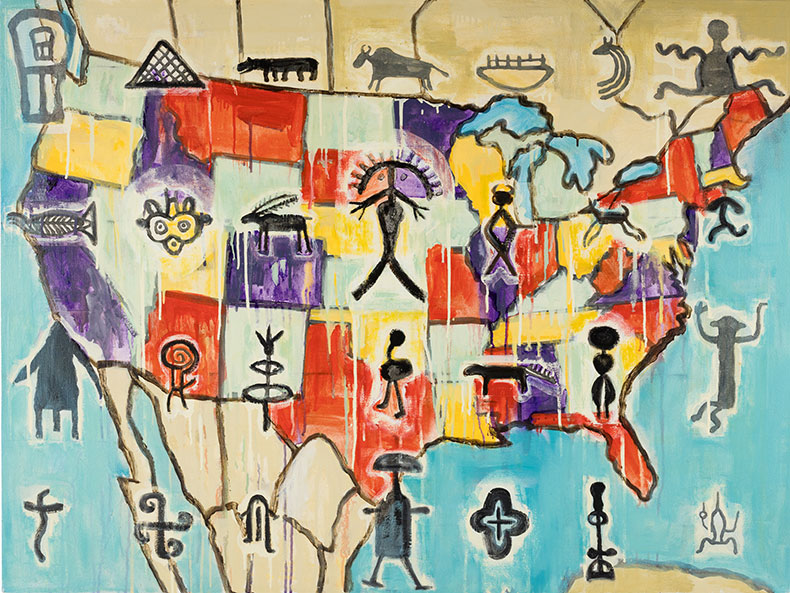
Other motifs that have become increasingly important include the canoe. Begun in 1992, her series of Trade Canoes includes both large-scale paintings on canvas and, in recent years, massive assemblage sculptures on which she collaborates with her son, Neal Ambrose-Smith. These canoes have provided Smith with vessels for everything from lament for the planet – as in Trade Canoe for the North Pole, filled with southern plants and animals to populate the warming north – to biting satire, with one particular Ship of Fools carrying George W. Bush in the guise of Don Quixote. Smith credits the satirical thrust of her work to a love of irreverent New York Times headlines (including, notably, ‘War Is Heck’, from which Smith made a lithograph in 2002 with a war horse cribbed from Leonardo da Vinci and a montage of Eadweard Muybridge cattle being led to slaughter). The Wallowa Waterhole series of the late 1970s was the earliest of what Smith now calls her ‘inhabited landscapes’, which have remained a constant in her practice ever since. Sometimes her landscapes respond to political events – the Petroglyph Park series was begun in 1985 in response to efforts by developers to build on the West Mesa (Smith has often described art and activism as going hand in hand). Others take their cues from historical events; the Chief Seattle series, completed between 1989–91, incorporates text from a famous speech given by the leader of the Suquamish and Duwamish peoples in negotiating the terms of the Treaty of Point Elliott in 1854. As often as not, though, Smith’s ‘inhabited landscapes’ are first and foremost a way of expressing the aliveness of the land.
War is Heck (2002), Jaune Quick-to-See Smith. © Jaune Quick-to-See Smith

As the show at the NGA will make clear, this subject is common ground for many other Native American artists – Smith’s theme is ‘landscape’, and all the works on show are a means of describing ‘how Native people see land’. But Smith is also keen to make clear the variety of approaches taken by the artists included, from the overtly political silkscreens of John Hitchcock to more serene depictions of place. She talks of the ways that her own work is often lumped into a box with that of her ‘community’. ‘If you invite me to do something, I will always crack that door and come through it and bring my community with me because that’ s what I do. That’s how we’ve survived.’ But that doesn’t preclude individuality, and perhaps this is her greatest hope for the Whitney exhibition: ‘I want them to leave thinking, “She’s an American artist” – not as something other. Because, you know, I’m an amalgam – I’m taking newspapers to use in collages, and then using my icons like the canoe or the bison to tell my stories from a Native worldview. And that’s just as American as any European that resides here.’
‘Jaune Quick-to-See Smith: Memory Map’ is at the Whitney Museum of American Art, New York, until 13 August. ‘The Land Carries Our Ancestors: Contemporary Art by Native Americans’ is at the National Gallery of Art, Washington, D.C., from 24 September–15 January 2024.
From the May 2023 issue of Apollo. Preview and subscribe here.

